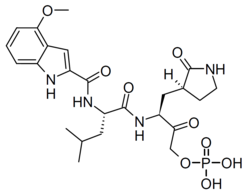Lufotrelvir
| Lufotrelvir | |

| |
| Structure du lufotrelvir. | |
| Identification | |
|---|---|
| Nom UICPA | phosphate de [(3''S'')-3-[[(2''S'')-2-[(4-méthoxy-1H-indole-2-carbonyl)amino]-4-méthylpentanoyl]amino]-2-oxo-4-[(3''S'')-2-oxopyrrolidin-3-yl]butyl] dihydrogène |
| Synonymes |
PF-07304814 |
| No CAS | |
| DrugBank | DB16514 |
| PubChem | 154699467 |
| ChEBI | 173073 |
| SMILES | |
| InChI | |
| Propriétés chimiques | |
| Formule | C24H33N4O9P |
| Masse molaire[1] | 552,514 ± 0,025 g/mol C 52,17 %, H 6,02 %, N 10,14 %, O 26,06 %, P 5,61 %, |
| Unités du SI et CNTP, sauf indication contraire. | |
| modifier |
|
Le lufotrelvir, ou PF-07304814, est un antiviral développé par le laboratoire pharmaceutique américain Pfizer agissant comme inhibiteur de protéase 3C-like des coronavirus[2]. Il s'agit d'un promédicament dont le groupe phosphate est clivé in vivo pour libérer le composé actif PF-00835231[3]. Le lufotrelvir est en essai clinique pour le traitement du COVID-19 chez l'homme et présente une bonne activité contre plusieurs variants du SARS-CoV-2, mais doit être administré par injection intraveineuse, contrairement au nirmatrelvir, ce qui a ralenti la finalisation de son développement[4],[5],[6].
Notes et références[modifier | modifier le code]
- Masse molaire calculée d’après « Atomic weights of the elements 2007 », sur www.chem.qmul.ac.uk.
-
(en) Robert L. Hoffman*, Robert S. Kania, Mary A. Brothers, Jay F. Davies, Rose A. Ferre, Ketan S. Gajiwala, Mingying He, Robert J. Hogan, Kirk Kozminski, Lilian Y. Li, Jonathan W. Lockner, Jihong Lou, Michelle T. Marra, Lennert J. Mitchell Jr., Brion W. Murray, James A. Nieman, Stephen Noell, Simon P. Planken, Thomas Rowe, Kevin Ryan, George J. Smith III, James E. Solowiej, Claire M. Steppan et Barbara Taggart, « Discovery of Ketone-Based Covalent Inhibitors of Coronavirus 3CL Proteases for the Potential Therapeutic Treatment of COVID-19 », Journal of Medicinal Chemistry, vol. 63, no 21, , p. 12725-12747 (PMID 33054210, PMCID 7571312, DOI 10.1021/acs.jmedchem.0c01063, lire en ligne
 )
)
-
(en) Britton Boras, Rhys M. Jones (...) et Charlotte Allerton, « Preclinical characterization of an intravenous coronavirus 3CL protease inhibitor for the potential treatment of COVID19 », Nature Communications, vol. 12, no 1, , article no 6055 (PMID 34663813, PMCID 8523698, DOI 10.1038/s41467-021-26239-2, Bibcode 2021NatCo..12.6055B, lire en ligne
 )
)
-
(en) Maren de Vries, Adil S. Mohamed, Rachel A. Prescott, Ana M. Valero-Jimenez, Ludovic Desvignes, Rebecca O’Connor, Claire Steppan, , Joseph C. Devlin, Ellie Ivanova, Alberto Herrera, Austin Schinlever, Paige Loose, Kelly Ruggles, Sergei B. Koralov, Annaliesa S. Anderson, Joseph Binder et Meike Dittmann, « A Comparative Analysis of SARS-CoV-2 Antivirals Characterizes 3CLpro Inhibitor PF-00835231 as a Potential New Treatment for COVID-19 », Journal of Virology, vol. 95, no 10, , e01819-e01820 (PMID 33622961, PMCID 8139662, DOI 10.1128/JVI.01819-20, lire en ligne
 )
)
-
(en) Mohammad Hassan Baig, Tanuj Sharma, Irfan Ahmad, Mohammed Abohashrh, Mohammad Mahtab Alam et Jae-June Dong, « Is PF-00835231 a Pan-SARS-CoV-2 Mpro Inhibitor? A Comparative Study », Molecules, vol. 26, no 6, , p. 1678 (PMID 33802860, PMCID 8002701, DOI 10.3390/molecules26061678, lire en ligne
 )
)
-
(en) Koen Vandyck et Jerome Deval, « Considerations for the discovery and development of 3-chymotrypsin-like cysteine protease inhibitors targeting SARS-CoV-2 infection », Current Opinion in Virology, vol. 49, , p. 36-40 (PMID 34029993, PMCID 8075814, DOI 10.1016/j.coviro.2021.04.006, lire en ligne
 )
)
